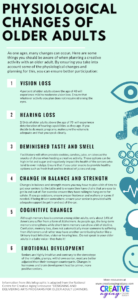We recently shared an infographic created by the arts health network on the benefits of participating in creative aging activities. Today we would like to share some more data from the National Centre for Creative Aging on the physiological changes practitioners and family members should be aware of when designing activities to engage in with older adults. By making sure your creative activity is accessible to those with physical challenges such as mild vision loss or poor hearing, you can ensure that these individuals will be more to participate again.
If an older adult participates in an art activity that causes them to strain their eyes or they can’t hear the instructions, they may become frustrated and not participate actively resulting in isolation, depression and anger. It’s best to be aware of the challenges and adapt so that all older adults can benefit.
In order to ensure research and resources are shared with as many members as possible, we have decided to summarize the information into infographics you can save, print and share!
Today’s infographic is on the Physiological Changes of Older Adults. Each individual will experience aging differently based on lifestyle, genetics, physical environment and diet. This infographic describes some of the common changes associated with normal aging.
Click on the infographic to enlarge and print!
Source: Information from this infographic is adapted from the National Centre for Creative Aging’s resource “DESIGNING AND DELIVERING ARTS PROGRAMS FOR OLDER ADULT LEARNERS.

